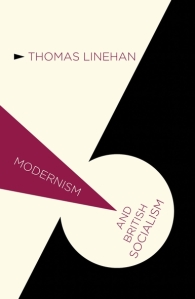Why did socialists create so many new utopian communities in the late nineteenth century? In his engaging short book on Modernism and British Socialism, Thomas Linehan revises the neo-Marxist notion of a ‘conjuncture’ (it sounds better in French) where a number of factors came together that encouraged a positive view of the world as it might be, a negative view of the world as it was, and an optimistic sense that an alternative was realistically achievable.
For Linehan, the socialist revival itself in the 1880s and 1890s reflected a belief that capitalism stood stood on ‘the cusp of profound and radical change’ (132). While urbanisation, mechanisation, scientific advance and economic growth had brought about an end to old ways of living, they had palpably failed to produce spiritual renewal and material prosperity for all, while also throwing old certainties into the dustbin of radical doubt. The result was what Linehan calls ‘an acute liminoid moment’ (28), when radicals were able to put into practice their values of fellowship, harmony and equality.
Linehan devotes a chapter to the socialist colonies, paying particular attention to the Tolstoyan settlements at Purleigh and Whiteway, the Christian socialist colony at Starnthwaite in Cumberland, and the Kropotkinite Clousden Hill Communist and Co-operative Colony near Newcastle, as well as the arts and crafts colony at Chipping Campden. He also mentions the one-man settlement of the Scot Douglas Semple, who went to live in a bell tent on Linwood Moss, near Paisley.
These ‘experiments in social modernism’ represented an attempted reconstruction of communal life in communion with nature, as well as a refusal of the spatial and temporal arrangements of modernity. Linehan contrasts these utopian impulses with ‘Fabian modernism’, which he presents as underpinned by a belief in the power of rationalism and science, as well as a strong sense that ‘progress’ was inexorably moving towards the collectivisation of social governance. Fabian efficiency, writes Linehan, was incompatible with and intolerant of the utopian colonies, which Sidney Webb deplored as sentimental expressions of pre-modern nostalgia.
This is a compelling account, and I wish I’d managed to read it before finishing my own study of British work camp systems. My fourth chapter is given over to a discussion of the utopian colonies, and on the whole I think my analysis and Linehan’s complement each other. His work is much stronger on the intellectual history of the period, though, and it forces us to rethink much of the socialist project of the late nineteenth century (and more recently, of course).
Where we part company is, I think, in his use of the term modernism. I’m generally sceptical over such portmanteau concepts as modernism and neo-liberalism, both because they jumble together much that is contradictory and because they tend to be deployed as non-personified actors rather than as general intellectual currents. And I think this has influenced Linehan’s account of the socialist colonies as well.
For one thing, any account of socialist utopian colonies has to acknowledge not only the various autonomous community building endeavours of small groups. It must also consider the ways in which socialists sought to use local government – particularly the poor law institutions – to develop labour colonies that were similarly inspired by the idea of building new, post-industrial and egalitarian communities. The work of George Lansbury and his allies in Poplar and elsewhere in London is the prime example, but there are others.
Science alone was not enough to render utopian colonies unrealistic. Alfred Russel Wallace, one of the great supporters of the labour colony movement, was himself a rationalist and a biologist, who is best known for independently developing the theory of evolution; he was also a spiritualist, and saw nothing contradictory in holding these views.
And this brings us back to the Fabians, who may have understood themselves as dispassionate and scientific, but were perfectly happy to develop plans for labour colonies as part of their wider vision of socialised efficiency. Equally, the Kropotkinites at Clousden Hill thought of themselves as promoters of the latest scientific techniques in agriculture. Science and community building were by no means mutually exclusive.
Finally, the utopian moment passed fairly quickly. Few of the socialist colonies survived more than a couple of years, and those that did survive – like Starnthwaite and Whiteway – had to change their goals and nature pretty drastically. It is then hardly surprising if Fabians thought them of little value in the years before the Great War, as by that time no socialist colonies existed. Interestingly, although the local government colonies also lost their utopian character, Lansbury supported them loyally to the last.
Modernism and British Socialism is a lively, well-written and intellectually fluent book. I thoroughly enjoyed reading it, and while I don’t agree with part of Linehan’s central argument, nor with his account of the socialist colonies, it helps us rethink the intellectual climate in late nineteenth century Britain and offers a stimulating account of early British socialism.


TThanks very much for this John. Will read it.